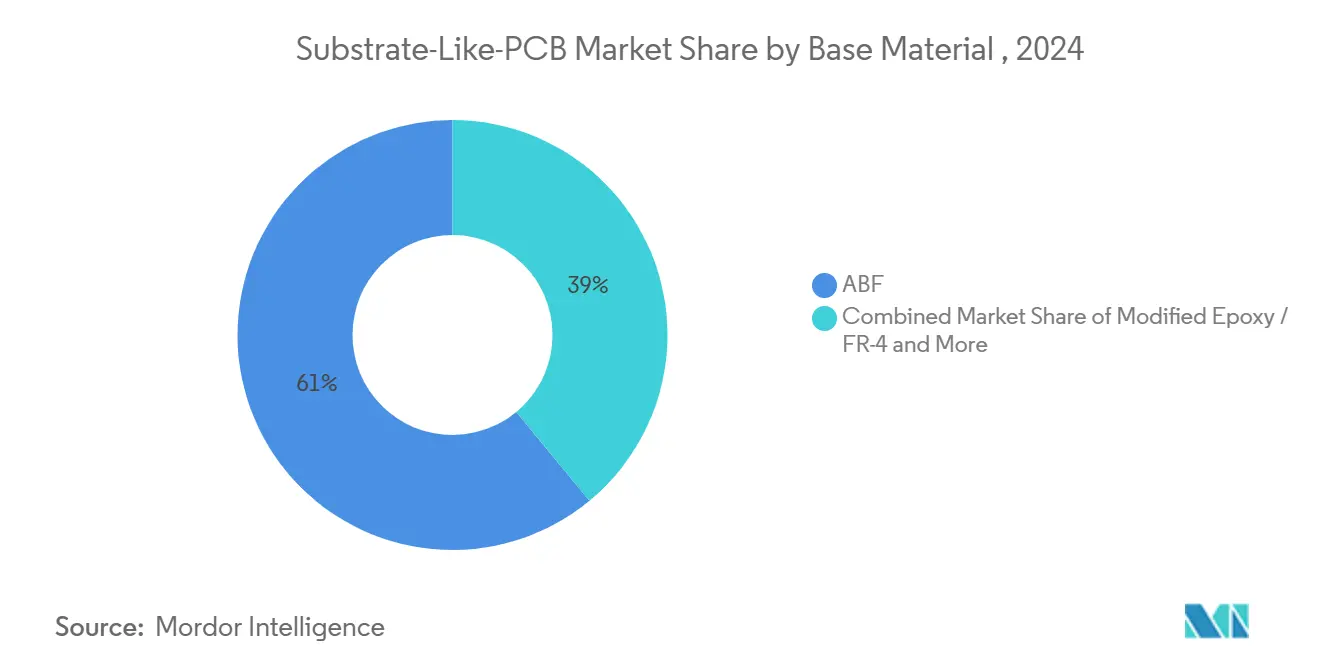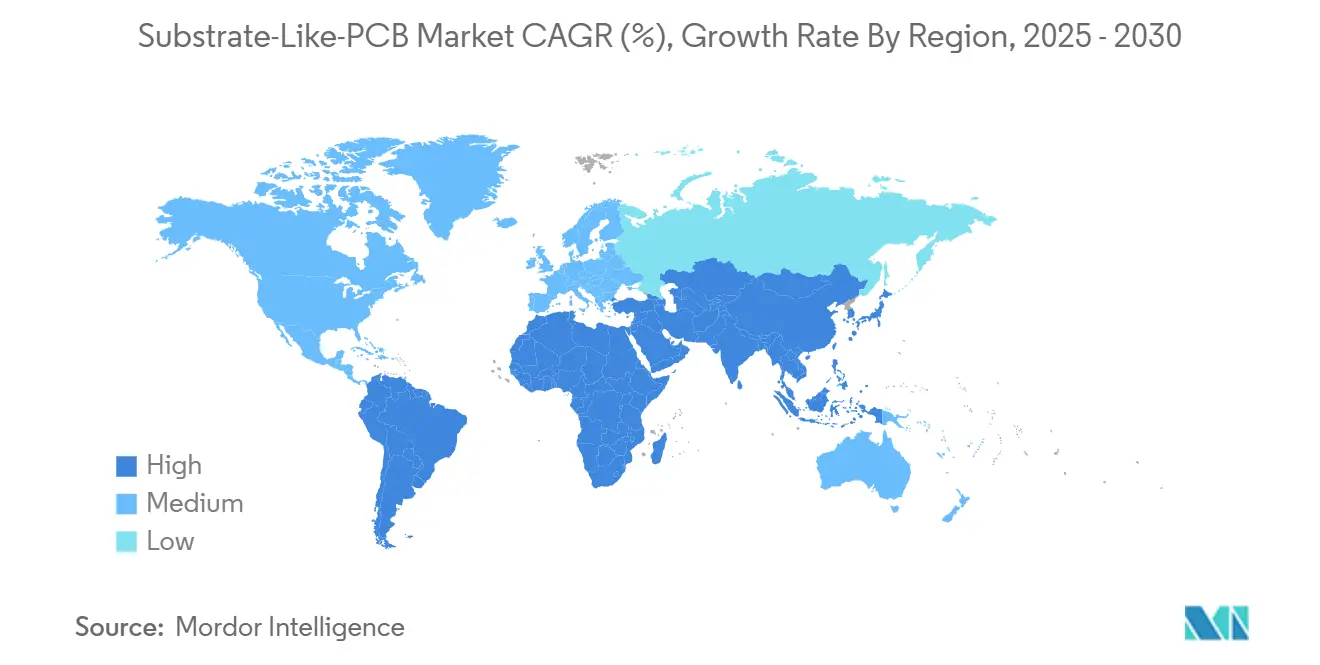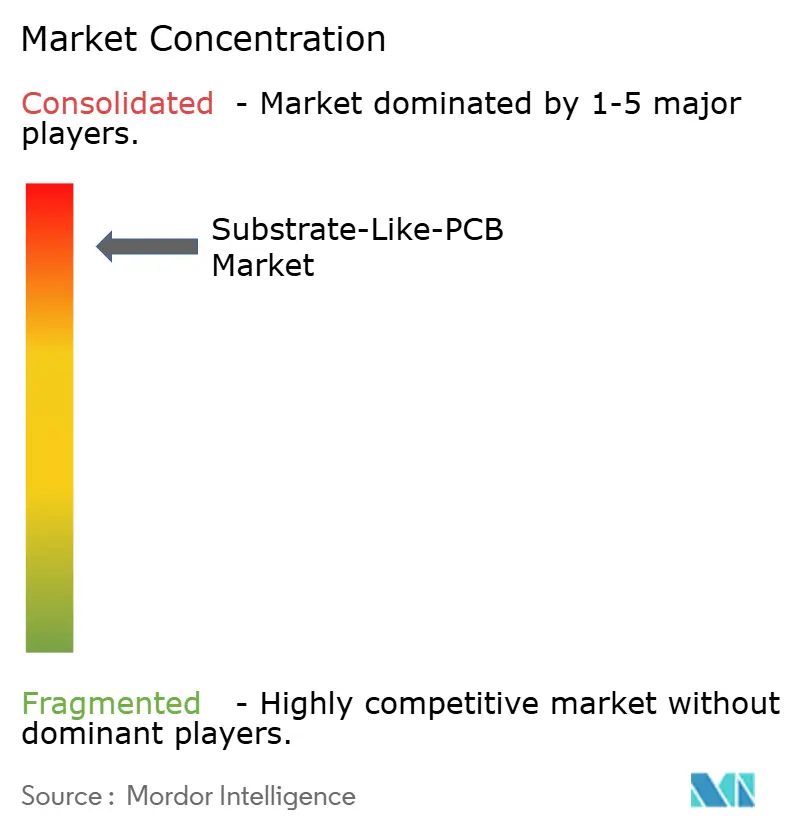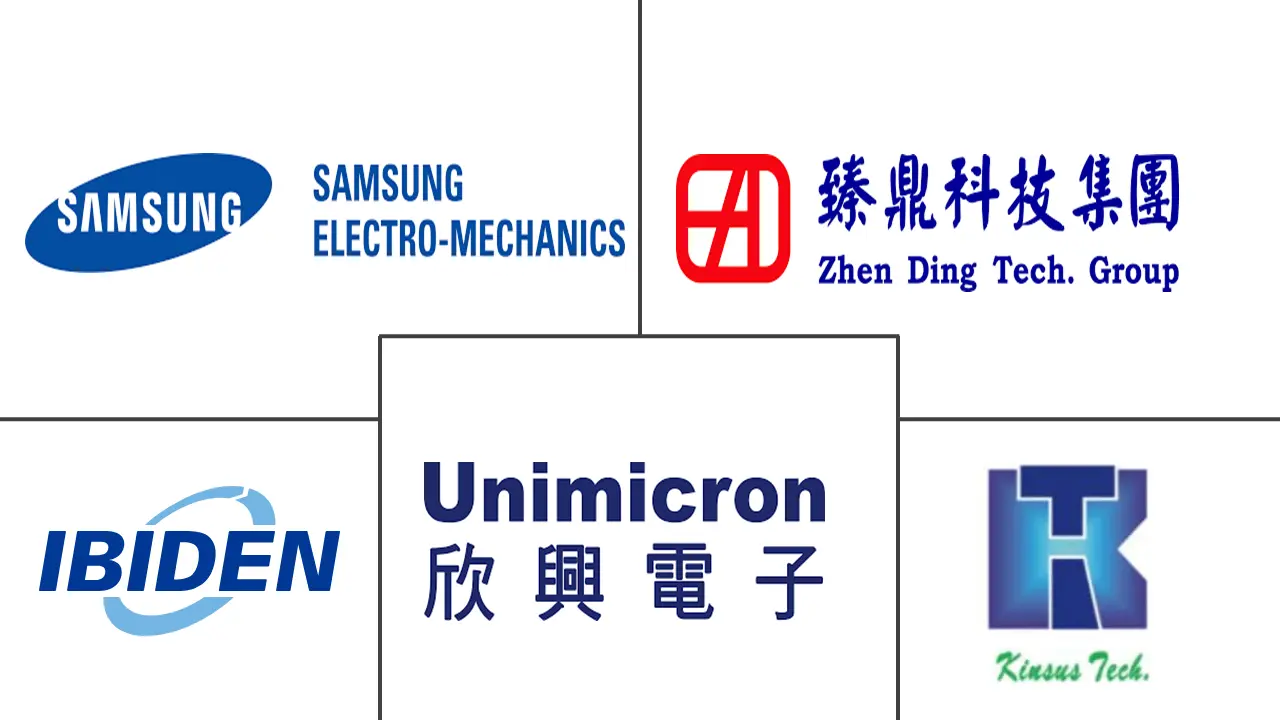Substrate-Like-PCB Market Size and Share

Substrate-Like-PCB Market Analysis by Mordor Intelligence
The Substrate-Like PCB market size reached USD 3.53 billion in 2025 and is forecast to advance to USD 6.85 billion by 2030, reflecting a 14.18% CAGR. Demand accelerates as OEMs migrate from conventional high-density interconnect boards to solutions that deliver IC-substrate-level wiring density without fully moving into semiconductor packaging. Volume growth is anchored in 5G radio, artificial-intelligence processors, and automotive ADAS controllers that require ≤25 µm line/space geometries for signal integrity. Asia-Pacific captured 69% of revenue in 2024, benefiting from tight linkages between semiconductor foundries and PCB fabricators plus sustained investment in modified semi-additive processing lines . ABF build-up films dominate material selection on the strength of low-loss dielectric properties, though their concentrated supply base prompts vertical-integration moves by tier-one fabricators.[1]Nikkei Asia staff, “Ajinomoto to Invest USD 165 Million to Boost Production of Chip Materials” Nikkei Asia, asia.nikkei.com Yield optimization below 25 µm increasingly hinges on AI-enabled inspection, giving process-control leaders a structural cost advantage. Geopolitical reshoring incentives—such as the USD 30 million U.S. Department of Defense grant—add regional diversification while tightening qualification hurdles for new entrants.[2]U.S. Department of Defense, “Department of Defense Awards USD 30 Million to Expand Domestic Printed Circuit Board Production” DoD, defense.gov
Key Report Takeaways
- By application, smartphones led with 47% of the Substrate-Like PCB market share in 2024; wearables are projected to grow at 15.4% CAGR through 2030.
- By build-up layer count, 10–12 layers commanded 37% share in 2024, while >12-layer solutions are set to expand at 13% CAGR.
- By base material, ABF films held 60% share of the Substrate-Like PCB market size in 2024.
- By line/space resolution, 25/25 µm boards accounted for 45% of the Substrate-Like PCB market size in 2024; ≤20/20 µm boards are forecast to rise at 14.5% CAGR.
- By geography, Asia-Pacific controlled 69% revenue in 2024, whereas South America is pacing a 12.2% CAGR.
- By company concentration, the top 10 manufacturers controlled 80% of Substrate-Like PCB market share in 2024.
Global Substrate-Like-PCB Market Trends and Insights
Drivers Impact Analysis
| Driver | ( ~ ) % Impact on CAGR Forecast | Geographic Relevance | Impact Timeline |
|---|---|---|---|
| Surging smartphone OEM adoption for high-density interconnects | +3.2% | Global, APAC core | Short term (≤ 2 years) |
| Rising demand for 5G communication modules | +2.8% | Global, North America & EU lead | Medium term (2–4 years) |
| Miniaturization trends in wearables & IoT devices | +2.1% | Global, strong in North America | Medium term (2–4 years) |
| Automotive ADAS & EV electronics escalating PCB complexity | +1.9% | Global, Europe & China focus | Long term (≥ 4 years) |
| Flip-chip on SLP enabling heterogeneous integration | +1.5% | APAC core, spill-over to North America | Long term (≥ 4 years) |
| Government subsidies for on-shore advanced PCB fabs | +1.2% | North America & EU | Medium term (2–4 years) |
| Source: Mordor Intelligence | |||
Surging smartphone OEM adoption for high-density interconnects
Premium handset vendors used Substrate-Like PCB market technology to raise circuit density by roughly 30%, unlocking more space for 5G modems, AI coprocessors, and multi-lens camera control while holding device thickness flat. Scale benefits from flagship models flow into mid-tier phones, sustaining high production runs that amortize capital costs across broader portfolios.
Rising demand for 5G communication modules
Millimeter-wave base-station boards and consumer 5G radio cards require ≤25 µm routing to curb insertion loss and crosstalk. Network OEMs specify Substrate-Like PCB market designs for massive-MIMO arrays and beam-forming front ends, linking board density with spectral-efficiency targets.[3]Panasonic Industrial, “5G Multi-Layer PCB Solutions”, Panasonic, industrial.panasonic.com The same design rules migrate into smartphones and tablets as data-rate expectations climb.
Miniaturization trends in wearables & IoT devices
Smartwatches, fitness trackers, and health patches need tighter component packing for longer battery life and more sensors. Substrate-Like PCB market layouts integrate power management, Bluetooth radios, and optical biosensors on a single stack, reducing enclosure height while improving heat dissipation. Regulatory clearance for medical-grade wearables adds revenue upside because reliability accreditation supports premium unit economics.
Automotive ADAS & EV electronics escalating PCB complexity
Radar fusion, LiDAR control, and high-current inverter boards push conventional automotive PCBs beyond practical via density. Substrate-Like PCB market architectures offer coefficient-of-thermal-expansion parity with silicon to endure vehicle temperature cycling, while fine-line routing supports sensor redundancy demanded by functional-safety standards. OEM roadmaps for software-defined vehicles keep density requirements on an upward slope through 2030.
Restraints Impact Analysis
| Restraint | ( ~ ) % Impact on CAGR Forecast | Geographic Relevance | Impact Timeline |
|---|---|---|---|
| High CAPEX for SLP production lines | –2.1% | Global, emerging markets | Short term (≤ 2 years) |
| Process-yield challenges at <25 µm L/S | –1.8% | Global, acute in new facilities | Medium term (2–4 years) |
| Source: Mordor Intelligence | |||
High CAPEX for SLP production lines
A greenfield Substrate-Like PCB market line requires precision laser drills, direct-imaging photolithography, and Class 1000 cleanroom space. The USD 100 million outlay pressures smaller fabricators to form joint ventures or exit, consolidating capacity with incumbents that boast balance-sheet depth.
Process-yield challenges at <25 µm L/S
Dimensional drift during lamination and alignment defects during sequential build-up hold yields below conventional HDI levels, narrowing margin buffers. New entrants must finance metrology upgrades and AI-guided inspection to reach break-even reliability. Facilities failing to master sub-25 µm control risk relegation to low-margin 30 µm work.
Segment Analysis
By Application: Smartphones Drive Scale, Wearables Propel Growth
Smartphones accounted for 47% of Substrate-Like PCB market revenue in 2024 and remain the anchor customer set entering 2025. The segment leverages the Substrate-Like PCB market size advantage inherent in global handset shipments to underwrite rapid capacity ramps. Premium devices that pair AI engines with 5-antenna 5G radios require ≤25 µm wiring, reinforcing demand at the leading edge. A cascading cost curve then enables mid-tier adoption, extending volume visibility beyond flagship refreshes.
Wearables are the fastest-growing niche at a 15.4% CAGR, catalyzed by health monitoring mandates and augmented-reality headsets. Suppliers optimize energy density by embedding high-efficiency power-management ICs directly onto the board, proving the value of SLP’s sub-0.5 mm via pitch. Automotive electronics add diversified revenue streams as OEMs specify redundant sensor-fusion boards. Networking infrastructure and edge-computing gateways adopt SLP to meet thermal and latency targets, while industrial and medical systems command premium ASPs due to stringent reliability.

Note: Segment shares of all individual segments available upon report purchase
By Build-Up Layer Count: Complexity Becomes Competitive Currency
The 10–12-layer cohort controlled 37% of 2024 output, balancing routing headroom with manageable yield risk. This stratum remains the workhorse for the Substrate-Like PCB market size tied to smartphone boards. Designs exceeding 12 layers are scaling at 13% CAGR on the back of chiplet-based AI accelerators and automotive domain controllers. Here, “Substrate-Like PCB market share” accrues to fabricators that master cumulative-warp control across sequential lamination cycles. Layer counts of 8–10 serve cost-sensitive consumer IoT products, offering an entry path for HDI vendors up-skilling toward SLP.
By Base Material: ABF Retains Leadership Amid Supply-Chain Scrutiny
Ajinomoto Build-Up Film held 60% share in 2024 thanks to its low dielectric loss and silicon-matched thermal expansion. Continuous debottlenecking, including a USD 166 million capacity add, keeps pace with demand for advanced GPU and CPU packages. Modified epoxy/FR-4 alternatives win on price for mid-range consumer devices, while PTFE and BT resins serve RF and harsh-environment niches. Regulatory pressure on PFAS accelerates R&D into eco-compliant dielectrics, signaling potential share rotation post-2028.

Note: Segment shares of all individual segments available upon report purchase
By Line/Space Resolution: Precision Dictates Profit Pools
Boards built at 25/25 µm lines captured 45% of 2024 shipments. This category defines today’s manufacturing sweet spot where Substrate-Like PCB market economics still align with consumer-electronics BOM targets. The ≤20/20 µm tier, expanding at 14.5% CAGR, closes the gap toward IC substrates and underpins heterogeneous integration strategies. Achieving such precision demands semiconductor-grade cleanroom protocols and machine-learning inspection algorithms, elevating capital burn but also forming high barriers to commoditization.
Geography Analysis
Asia-Pacific retained a 69% revenue share in 2024, anchored by Taiwan, South Korea, and Japan. Foundry-adjacent ecosystems accelerate design-for-manufacture cycles, letting PCB vendors co-opt R&D from semiconductor customers. Chinese fabricators expand capacity aggressively; Zhen Ding booked 23% top-line growth in 2024 and is steering toward 50% CAGR in IC-substrate revenue through 2027. Material majors in Japan supply ABF films to the region, reinforcing local supply-chain density.
North America contributed 18% in 2024 but benefits from USD 30 million defense funding plus CHIPS Act incentives that defray advanced tooling. TTM Technologies’ USD 130 million Syracuse facility constitutes the largest ultra-HDI investment on the continent, targeting secure-supply defense workloads. Automotive electrification and private-network 5G rollouts give regional demand a structural leg.
Europe’s smaller yet strategic footprint is led by AT&S, which extended Malaysian production to serve German OEMs needing ADAS boards. EU grants targeting technology sovereignty support incremental SLP lines, especially for automotive and medical verticals.
South America, though starting from a low base, records a 12.2% CAGR as near-shoring shifts light assembly to the Dominican Republic and Mexico. Governments promote electronics clusters for job creation, drawing pilot SLP investment to align with free-trade agreements.
The Middle East and Africa remain nascent but preserve upside through sovereign diversification funds channeling capital into semiconductor back-end ecosystems, enabling future Substrate-Like PCB market penetration once regional design houses mature.

Competitive Landscape
The Substrate-Like PCB market features moderate concentration: the ten largest suppliers own 80% of capacity. Ibiden, Unimicron, and Zhen Ding deploy continuous yield-improvement roadmaps focused on AI-driven defect analytics, cutting scrap costs at ≤20 µm geometries. Capital intensity favors incumbents; a single next-generation line exceeds USD 100 million, deterring greenfield entrants.
Strategic differentiation gravitates toward vertical integration. LG Innotek’s “Dream Factory” adds ABF substrate output, capturing margin from materials while shortening lead times for anchor smartphone customers. Fabricators are also acquiring inspection-tool start-ups to internalize algorithmic IP, ensuring process data exclusivity.
White-space expansion targets automotive ADAS and edge-server boards. SLP-capable vendors leverage smartphone volume know-how to win automotive PPAP certification, locking in multiyear supply contracts as vehicle electronics content rises. Simultaneously, edge AI hardware Bundles high-bandwidth memory, CPU, and accelerator dies on SLP carriers, feeding demand for >12-layer builds—a skillset mastered by only a handful of plants globally.
Substrate-Like-PCB Industry Leaders
-
Ibiden Co., Ltd.
-
Kinsus Interconnect Technology Corp.
-
Unimicron Technology Corp.
-
Samsung Electro-Mechanics
-
Zhen Ding Technology Holding
- *Disclaimer: Major Players sorted in no particular order

Recent Industry Developments
- April 2025: LG Innotek unveiled the “Dream Factory” to pioneer PC-CPU ABF substrate output, signaling a forward-integration play that secures captive material for its packaging lines while opening an external revenue stream
- March 2025: Zhen Ding Technology posted NT$171.7 billion revenue in 2024 and set a 2023-2027 IC-substrate CAGR goal above 50%, positioning for leadership in the ≥12-layer Substrate-Like PCB market tie
- March 2025: Ajinomoto earmarked USD 166 million for ABF capacity expansion, diversifying revenue beyond food into electronic materials and mitigating supply-tightness risk for high-frequency packages
- February 2025: TTM Technologies opened a 215,000 sq ft ultra-HDI site in Syracuse to serve aerospace and defense clients requiring controlled supply chains
Research Methodology Framework and Report Scope
Market Definitions and Key Coverage
According to Mordor Intelligence, our study defines the Substrate-Like Printed Circuit Board (SLP) market as all newly manufactured rigid boards with copper line and space below 30 um, produced through modified semi-additive processes that deliver IC-substrate-level density for smartphones, tablets, wearables, automotive radar modules, networking gear, and advanced industrial controls.
Scope Exclusions: We exclude flexible circuits, ceramic or organic IC package substrates, and conventional HDI boards that use wider trace geometries.
Segmentation Overview
- By Application
- Smartphones
- Tablets
- Wearables
- Automotive Electronics
- Networking and Communication Infrastructure
- IoT / Edge Devices
- Industrial and Medical Electronics
- By Build-Up Layer Count
- 8 - 10 Layers
- 10 - 12 Layers
- > 12 Layers
- By Base Material
- ABF (Ajinomoto Build-up Film)
- Modified Epoxy / FR-4
- Others (PTFE, BT Resin)
- By Line/Space Resolution
- 30 / 30 µm
- 25 / 25 µm
- 20 / 20 µm
- By Geography
- North America
- United States
- Canada
- Mexico
- South America
- Brazil
- Argentina
- Rest of South America
- Europe
- United Kingdom
- Germany
- France
- Italy
- Spain
- Russia
- Rest of Europe
- APAC
- China
- Japan
- South Korea
- India
- Australia
- Rest of APAC
- Middle East and Africa
- GCC
- South Africa
- Rest of Middle East and Africa
- North America
Detailed Research Methodology and Data Validation
Primary Research
To extend and verify desk findings, we spoke with fabrication managers, materials chemists, smartphone design engineers, and electronics distributors across Asia-Pacific, North America, and Europe. These discussions clarified layer-count adoption paths, feasible yield ramps, and real-world pricing corridors, which then guided sensitivity tests inside the forecast workbook.
Desk Research
In the first stage, our analysts gathered foundational figures from tier-one public sources such as the International Data Corporation smartphone tracker, GSM Association 5Grollout database, WSTS semiconductor shipment tables, UN Comtrade customs statistics, and releases from the Institute of Printed Circuits. Company 10-K filings, investor presentations, and respected press reports were mined to capture average selling price shifts and capacity announcements. Where deeper revenue splits were needed, we referred to licensed repositories from D&B Hoovers and Dow Jones Factiva to cross-check producer footprints. This evidence bank provided the production volumes, device growth outlook, and price benchmarks that seed the model. The sources listed are illustrative only; many additional documents were reviewed for validation and clarification.
Market-Sizing & Forecasting
Our model follows a top-down build that begins with global smartphone, wearable, and automotive electronic unit counts, which are then multiplied by calculated SLP penetration rates drawn from teardown databases, survey feedback, and published design wins. Results are corroborated with selective bottom-up checks; for example, sampling shipment data for key board makers and aligning average selling prices. Core variables include average layers per board, copper-thickness migration, handset replacement cycles, 5Gmix, and regional capacity utilization. Multivariate regression blends these drivers with macro indicators such as semiconductor billings and consumer disposable income to project values through 2030. Where supplier roll-ups diverged from demand pools, analysts applied interview-backed yield adjustments.
Data Validation & Update Cycle
Before release, our Mordor analysts run anomaly scans, compare outputs with independent metrics, and escalate any variance for peer review. The study is refreshed every twelve months, with interim updates triggered by material events like tariff revisions, factory fires, or major capacity additions.
Why Mordor's Substrate-Like PCB Baseline Carries Dependability
We recognize that published estimates often diverge, driven by scope choices, currency bases, and refresh cadence, and because some providers skip on-the-ground checks.
Key gap drivers here include whether flexible and IC package substrates are pooled with SLP, how handset ASP erosion is modeled, and whether China-centric capacity bottlenecks are captured.
Benchmark comparison
| Market Size | Anonymized source | Primary gap driver |
|---|---|---|
| USD 3.53 B (2025) | Mordor Intelligence | |
| USD 12.13 B (2024) | Global Consultancy A | Bundles flexible circuits and IC substrates, applies one global ASP |
| USD 1.50 B (2024) | Industry Publisher B | Uses conservative smartphone penetration and omits automotive and IoT demand |
The comparison shows that while others either broaden or narrow the scope, Mordor's disciplined variable selection, verified price ladders, and annual refresh give decision makers a balanced and traceable benchmark.
Key Questions Answered in the Report
What is driving the rapid growth of the Substrate-Like PCB market?
Migration to 5G radios, AI processors, and automotive ADAS boards that demand ≤25 µm line/space wiring underpins the 14.18% CAGR.
Why are smartphones so important for Substrate-Like PCB suppliers?
Smartphones supplied 47% revenue in 2024, giving fabricators the volume scale to amortize USD 100 million production lines and push yields upward.
How does ABF film influence competitive positioning?
ABF held 60% share in 2024; vendors with captive or preferred supply hedge against material shortages and secure high-frequency design wins.
Which geography is growing the fastest?
South America is projected to expand at 12.2% CAGR as near-shoring shifts assembly closer to U.S. and EU consumer markets.
Page last updated on:



